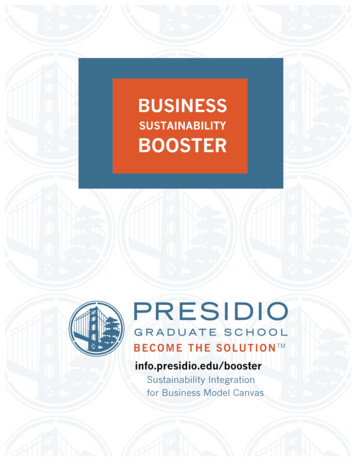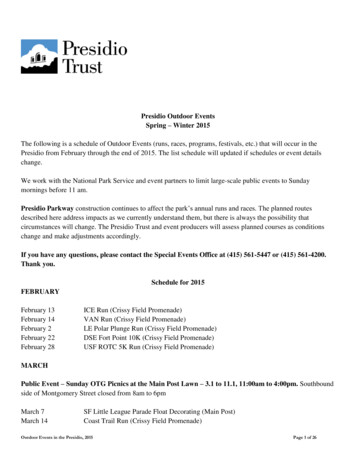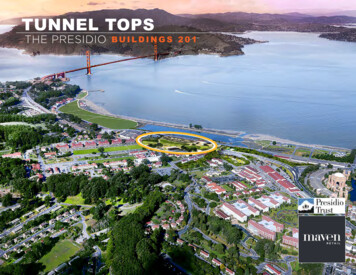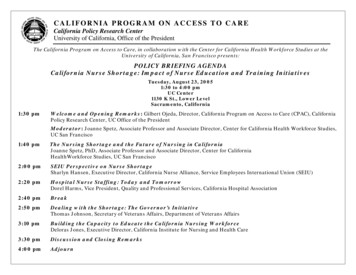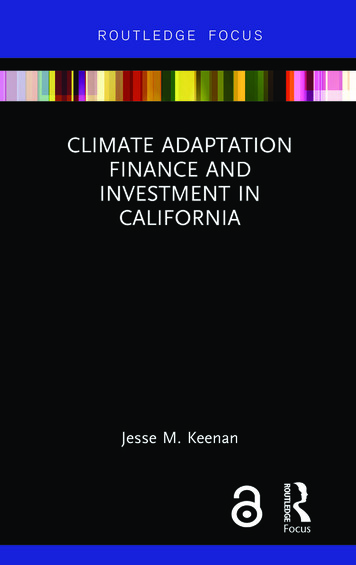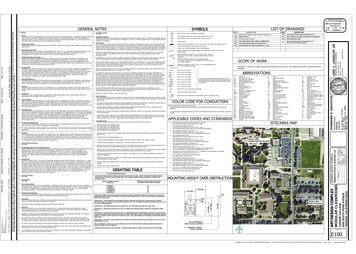
Transcription
PRESIDIO PARKWAY AVAILABILITY PAYMENT PUBLIC FINANCING PRIVATE FINANCING CALIFORNIA PROJECT TIFIA LOAN COMPLEX CONSTRUCTIONPRESIDIOPARKWAYSAN FRANCISCO, CAFINANCIAL CLOSE14 June 2012OPENED TO TRAFFICJuly 2015DELIVERY METHODDBFOM, 30 yearsCAPITAL VALUE 360 millionFINANCINGPrivate, Availability Payment, Facility NotTolledROUTEMulti-modal access to The Presidio ofSan FranciscoRIDERSHIPApprox. 120,000 trips per daySacramentoSan FranciscoPresidioParkwayLos AngelesPROJECT FINANCE ADVISORY LTDBACKGROUND PROJECT DRIVERSThe Presidio Parkway is the new south access to the iconic Golden Gate Bridge,which connects San Francisco to the North Bay counties. It replaced the originalaccess structure, known as Doyle Drive, which was built together with the bridge in1936. Doyle Drive was originally designed as a series of viaducts to fly over whatwas then a military base, the Presidio of San Francisco. Built to the standards ofthe 1930s, with six narrow lanes, no shoulders, and no dividing barrier between thetwo directions of travel, the facility could not handle even minor traffic incidentswithout creating major backups on the bridge.Calls for the replacement of Doyle Drive started as early as 1955, when the StateDivision of Highways, responding to the post-war traffic boom, proposed a projectas part of a large freeway expansion plan in San Francisco; but in 1966 thefreeway revolt movement put a stop to all new freeway construction plans in thecity. Head-on collisions and traffic jams kept Doyle Drive periodically in the publiceye, but the next major step did not occur until 1989, when Congress voted to closethe Presidio military base, eventually giving rise to the initiative to make it into amajor urban national park. The concept of undergrounding part of the facility, tolessen noise and pollution impacts while providing improved multi-modal access tothe park, dates back to that period. In October of that year, the Loma Prietaearthquake doomed the Embarcadero freeway and brought into focus the seismicdeficiencies of Doyle Drive.In 1991, the San Francisco Board of Supervisors established the Doyle Drive TaskForce. The Task Force considered design options and made recommendationsthat were approved in 1993. In 1994, the National Park Service released the FinalGeneral Management Plan Amendment (“GMPA”) identifying the main objectivesfor Doyle Drive improvements, which focused on maintaining the historic value ofthe surrounding areas, minimizing noise and pollution impacts and enhancingPresidio access and circulation features.That same year, the San Francisco County Transportation Authority (“theAuthority”) initiated the Doyle Drive Intermodal Study. Completed in 1996, andconsistent with the general design concepts from the Task Force and GMPAreports, this document was crucial in confirming the replacement of Doyle Drive as1
PRESIDIO PARKWAYFINANCIAL CLOSE14 June 2012OPENED TO TRAFFICJuly 2015DELIVERY METHODDBFOM, 30 yearsCAPITAL VALUE 360 millionFINANCINGPrivate, Availability Payment, Facility NotTolledROUTEMulti-modal access to The Presidio ofSan FranciscoRIDERSHIPApprox. 120,000 trips per dayPROJECT FINANCE ADVISORY LTDa San Francisco infrastructure investment priority. By detailing the likelydevastating traffic impacts on the regional highway network, and on the regionaleconomy, from a potential earthquake-induced Doyle Drive closure, the Authority’sstudy kicked off the process of establishing the replacement of Doyle Drive as amajor regional priority for funding, and it cemented a partnership with Caltrans, thefacility’s owner, but one where the Authority played the lead role in championingthe project and securing federal funds for it, and managing the local and regionalconsensus-building process.Subsequently, the Authority obtained a 6 million federal earmark to continuestudying the project and initiate environmental evaluation. The historic assessmentfor the project began in 2000. At the November 2003 ballot, the Authoritysucceeded in reauthorizing the local sales tax for transportation, which included 100 million for the Doyle Drive replacement project, creating a tangible source oflocal matching funds to leverage state and federal dollars for the project. The DraftEnvironmental Impact Statement/Report (“DEIS/R”) was released in 2005. OnSeptember 26, 2006, the Authority Board unanimously selected the PresidioParkway as the Preferred Alternative for the replacement of Doyle Drive. The FinalEnvironmental Impact Statement/Report (“FEIS/R”) was certified on December 16,2008, clearing the way for the detailed design and construction phases of theproject. The project’s cost estimate had climbed by then to over 900 million, andthe funding gap was close to 200 million.2
PRESIDIO PARKWAYDELIVERY METHOD ASSESSMENTIn 2009, the Authority began discussions with Caltransand the California Transportation Commission (“CTC”) forconsideration of the Presidio Parkway as a public privatepartnership (“P3”), under California’s newly approved P3legislation, SB4. Later that year, citing urgent concernsabout the seismic vulnerability of the existing structure,the Caltrans Director ordered the project divided in twophases and expedited for construction. The phasing plancontemplated the construction of the southbound portionfirst, using the traditional design-bid-build (“DBB”) deliverymethod, followed by a second phase, which would buildthe rest of the project using a P3.The decision helped to expedite the project’s initiation anddeal with internal challenges raised by the designengineers’ union at Caltrans, the Professional Engineersin California Government (“PECG”). However, it also hadits downsides, restricting opportunities for creativity indesign and construction methods in Phase II, increasingcontractor interface risks and reducing the potentialbenefits of the P3 by reducing its overall size and tying itsscope and schedule to those of Phase I. A number ofcomponents initially slated to be delivered in Phase Iended up being shifted to Phase II, creating contractualcomplexities and opportunities for claims by theconcessionaire that eventually resulted in costs foradditional scope, which would likely have been lower ifthey had been planned as part of Phase II from the start.To assess the benefits of alternative delivery methods abusiness case study and Value-for-Money (“VFM”)analysis was initiated comparing different project deliveryalternatives. In comparing delivery methods, the DBBoption was used as the Public Sector Comparator(“PSC”), against which the Design-Build-Finance (“DBF”)and the Design-Build-Finance-Operate-Maintain(“DBFOM”) alternatives were evaluated. The analysisincluded both quantitative and qualitative aspects. Thequantitative analyses used a net present value (“NPV”)approach to compare the life-cycle costs of the two P3options (DBF and DBFOM) with the traditional DBBapproach.The analysis showed that the DBFOM delivery optionoffered the best value for the project. In a DBFOM, thegovernment makes certain fixed payments as constructionmilestones are reached. Then, over the term of thePROJECT FINANCE ADVISORY LTDcontract (in this case 30 years), the government makesfixed annual payments to compensate the privateconcessionaire for the expense of operating andmaintaining the facility to the contractually agreed-uponstandards, and to repay equity contributed to the projectby the concessionaire and provide a return on investment.The analyses showed that the DBFOM approach wouldcost 147 million (23%) less than the traditional DBBapproach and achieve greater VFM over the project’s lifecycle. Some issues were not easily expressed inmonetary terms and a qualitative assessment had to beconsidered for these three delivery options.The timing of availability of funds was a compelling issue.In order to go with the traditional DBB delivery option,Caltrans and the Authority would have to ensure that allcommitted project funding was available up front toaddress all costs within a three-year construction period.Some of the funding, however, would only be availableover a longer period of time, as dictated by county sharesand other funding program guidelines, resulting inconstruction delays which would increase the cost of theproject and reduce user benefits. The use of privatefinance in both the DBF and DBFOM options would allowCaltrans and the Authority to better match the timing ofpayments with anticipated revenue availability over alonger period of time. In addition, adopting a P3 approachfor the project created short-term funding programcapacity for Caltrans to address other projects around thestate, because less funding was required up front for thePresidio Parkway. This was particularly relevant at thetime, because the state was dealing with the effects of theGreat Recession and the State Highway Account wasnearly depleted.The CTC approved the entry of the Presidio Parkwayproject into the P3 procurement track in May 2010. The3
PRESIDIO PARKWAYaction took place over several months and it was thesubject of fierce debate. CTC staff recommended againstthe project, arguing that the recession provided anopportunity to build the project cheaper using thetraditional method. The Authority argued that final pricewould not be the same as the low bid, especially on aproject of this complexity, and pointed to the businesscase study of the Caltrans track record, whichdemonstrated that on projects with an initial cost estimateof over 300 million, delivered traditionally through DBB,the likely cost overrun level at completion was 60% overthe initial budget. The CTC eventually voted to overridethe staff recommendation and approve the P3, but it doingso it lowered the maximum annual availability paymentlevel from 40 million to 35 million. The change did notdeter the market from bidding on the project.PROCUREMENT BENEFITSTransfer project risk to private partner:The DBFOM option offered a more extensive andappropriate transfer of risks to the private sector. Thisoption transferred key risks related to construction (suchas construction means and methods, construction quality,and long-term asset performance) to the party best able tomanage them, which is a private company who has abusiness model dedicated to delivering these services.The concessionaire is responsible for both project deliveryand long-term operations and maintenance. Caltrans andthe Authority would be protected from any cost overrunsor price escalation due to delays. In addition, there werematerial benefits to delivering the design, construction andmaintenance as part of an integrated strategy under onecontract, minimizing interface risk, and optimizingeconomies of scale and opportunities for collaborationacross multidisciplinary teams.PROJECT FINANCE ADVISORY LTDAlignment of interests:The DBFOM commercial structure, contracts, andfinancial security packages assisted in aligning theincentives of the concessionaire with those of Caltransand the Authority. The concessionaire has a strongincentive to achieve project performance specifications forconstruction, operations, and maintenance becausedocumented failure to meet performance standards willreduce the size of the annual availability payment. Thisreduces the return on investment for the concessionaire’sinvestors who, in turn, will apply internal pressure to meetperformance standards and avoid financial penalties.Greater price and schedule certainty:P3s allow government agencies to share risks with, or insome cases entirely transfer certain risks to a privatesector developer who has proven experience dealing withsuch risks and has developed strategies to mitigatepotential delays and cost increases that can result fromsuch risks. In addition, the concessionaire must build theproject first and get it ready for operation and the publicagencies get to formally inspect it and accept it beforethey authorize a significant milestone payment. Theagencies can also achieve greater price certainty fromP3s because the contracts often have a maximum price,which means that the private partner must pay for anycost increases above the agreed upon price. In a DBB,which is awarded to the lowest responsive bid, changeorders and time charges during construction can mean abig difference. The final cost is usually much higher thanthe lowest bid, especially for larger, complex projects.Cost efficiencies:Due to the integration and innovation that can beachieved in construction of large scale DBFOMs,significant cost savings can be realized against original4
PRESIDIO PARKWAYconstruction estimates. Here is a striking comparison: thePresidio Parkway construction costs for Phase I, whichrepresents approximately one-third of the physical scope,were 370 million. By contrast, Phase II (the P3 phase),which represents approximately two-thirds of the physicalscope, cost approximately 385 million. Therefore, the P3delivered almost twice the scope for virtually the sameprice based on these interim results.The annual affordability limit set by the CTC was 35million and the P3 agreement at financial close was 22million, approximately 37% below the affordability limit.These payments are fixed over the concession term, butsubject only to inflation or deductions due to poorperformance by the private partner. These paymentcertainties make for easier annual budgeting and fiscalplanning.“Freed up” public funds for other uses:In an availability payment-based DBFOM, the governmentpays a portion of the total cost of the project duringconstruction and the remainder is paid over the 30-yearconcession term. This minimizes the need to raise publicdebt to complete a project. It also frees up other availablecash to be used towards other projects. Therefore, usinga private sector concessionaire to access capital can freeup government funds to advance the construction of otherinfrastructure projects in the near-term and, therefore,provide the public with access to improved infrastructuresooner than would otherwise be possible with traditionaldelivery methods.PROJECT FINANCE ADVISORY LTDPerformance-based asset management:Under a P3 agreement with availability payments, thepublic agency gets to deduct a portion of the annualpayment if the concessionaire fails to maintain the assetto the contractually agreed performance standards, asinspected according to specified procedures. This meansthe public sector effectively receives a 30-yearperformance and quality warranty and the private sector isincentivized to operate and maintain the assetappropriately over the concession term. At the end of thecontract term, the government will regain operating controlof the asset and the asset will have a pre-determineduseful life left in it because of the routine and regularmaintenance level specified in the contract.Throughout the concession period, rehabilitation costs arethe responsibility of the private sector; this also meansthat there are no surprises, as far as major investmentsneeded by the public sector over that period. Thissimplifies budgeting and fiscal planning and ensures thecontinued, safe operation of the project.SustainabilityA sustainability program for the project was built into theP3 performance and payment mechanism, to incorporatesustainability principles throughout the design,construction, operation and maintenance of the project. In2015, the Presidio Parkway became the firstGreenroads Certified State Highway Project inCalifornia.5
PRESIDIO PARKWAYPROCUREMENT APPROACHThe overall P3 competitive procurement approach forPhase II was as follows: December 2008: Environmental assessmentcompleted February 2010: Issued Request For Qualifications(“RFQ”) and submitted the project proposal to theCTC May 2010: The CTC approved the proposal;Issued draft Request For Proposals (“RFP”) October 2010: Three bidders shortlisted; Issuedfinal P3 Agreement January 2011: Awarded contract to Golden LinkPartners (“GLC”); Commercial Close November 2011: California State Supreme Courtdenies legal appeal by PECG (the last of threecourt decisions in the case) June 2012: Financial Close July 2015: Project completed and open for trafficFollowing the RFQ, Caltrans/Authority announced threecompanies as being qualified for the potential P3 inApril 2010. These companies qualified based ondemonstrated successful experience on similar sizedprojects in the past. The shortlisted teams were; Golden Link Partners: Meridiam InfrastructureNorth America and Hochtief PPP Solutions NorthAmerica in a 50/50 equity venture. Theirconstruction team comprised of Kiewit and FlatironConstruction. Golden Gate Access Group: ACS InfrastructureDevelopment, with a construction team ofDragados, the local employee-owned CC Myersand design firm CH2MHill. Royal Presidio San Francisco Partners: GlobalviaInfrastructure (equity member, lead O&M), FCCConstruction, Tutor Perini Corporation and theParsons Transportation Group as lead engineer.The proposed P3 approach was controversial. PECG,the state-employed engineers union, strongly criticizedthe P3 concept and argued that tolls and user feeswere required by law for P3 transportation projects.They also argued that the proposed P3 project did notgo through the normal procedures developed to ensurepublic funding accountability. State officials respondedthat the state law does not prohibit the governmentfrom using availability payments for P3 projects and thestate can benefit from the P3 arrangement bytransferring risks to GLC.On November 2, 2010, PECG filed a lawsuit to blockthe P3 procurement and claimed that the process wasillegal. On December 22, 2010, the Superior Court inAlameda Country granted a temporary restraining order(“TRO”) to restrain Caltrans from awarding the contractto GLC while the complaint was considered. The TROwas lifted on January 3, 2011, and Caltrans and theAuthority signed the P3 contract with GLC for Phase II.Financial close was reached in June 2012 and theproject opened in July 2015.ORGANIZATION CHART (PHASE II)PROJECT FINANCE ADVISORY LTD6
PRESIDIO PARKWAYCOSTS AND FINANCINGGLC will be repaid over the 30-year period with theannual availability payments. Note; the facility was nottolled. The project was financed with;Bank Debt: A 170 million, 3.5-year bank facility, whichpriced at 180 bps over monthly LIBOR, fundedconstruction until GLC received a milestonepayment from Caltrans and the Authority. Thebank facility came from a group of fiveinternational banks; BBVA, BMO, BTMU,Santander and Scotia Capital. The five banks allcontributed equally to the loan. Once construction was complete, GLC wasentitled to receive availability payments of 22million per year during the 30-year concession,subject to inflation adjustment. These paymentswere used to cover operations and maintenancecosts, fund major maintenance reserves, and paya modest return on equity.TIFIA Loan GLC received two tranches of a TIFIA loan; ashort-term tranche for 90 million and a long-termtranche for 60 million. This was the first projectwith direct Federal-aid participation in availabilitypayments and the first TIFIA loan to be repaid inpart with a milestone payment following substantialcompletion. The short-term tranche, which helps coverconstruction costs, had an interest rate of 0.46%,and the long-term tranche, which expires in 2045,had an interest rate of 2.71%. GLC had once planned to issue up to 150 millionin private activity bonds (“PABs”) but decided theproject was better suited for bank financing as thecost of debt for the bonds would be slightly higher.Equity Contributions GLC contributed 46 million in equity, split evenlybetween Hochtief and Meridiam, resulting in adebt-to-equity ratio of 87.5:12.5.CONSTRUCTIONThe risks to the schedule and to the budget weresignificant: The existing highway had to remain open to trafficthroughout the construction phase; Sixteen state and federal agencies either havejurisdiction over portions of the right-of-way or hadto be consulted for other reasons; Several different construction contractorsdepended on the timely implementation of andinterface with separate construction contracts forPhase I to be able to access the site and delivertheir portion of the overall project on time and onbudget.Construction cost increases: At completion, Phase I costs were 391 million,which was a 24% increase over the budget and61% increase over bid. Phase II had a 9% increase over budget, based onchange orders supported by the project reviewboard. It is important to stress that the Caltrans iscurrently recommending paying over 100 millionin additional compensation to the concessionairefor disputes related to extra costs, but the vastmajority of these costs, as documented byCaltrans’ own report to the CTC, are for scopeincreases requested by Caltrans.Construction schedule impacts: Phase I planned delivery was 20 months, againstan actual 48. Phase II was delivered as planned, in 51 months,and it delivered twice the scope value of Phase IPROJECT FINANCE ADVISORY LTD7
PRESIDIO PARKWAYand most of the complex structures, includingthree of the four tunnels, the Park Presidio andGirard Street interchanges, and all of the complexlife safety systems.In April 2012, traffic was shifted onto a seismically-safetemporary bypass that carried traffic until Phase II wascomplete in July 2015.OPERATIONSThe project is open to traffic. Over the long-term GLChas to ensure a safe and durable facility over the 30year contract term. GLC is responsible for operationand maintenance of the entire project facility, includingall Phase I and Phase II elements.PROJECT FINANCE ADVISORY LTD8
PRESIDIO PARKWAYPROJECT CAPITAL COSTS & PUBLIC FUNDING SOURCES (JUNE 2012)Capital CostPhase IPhase IIDesign-Bid-BuildPublic-private partnershipEnvironmental 27,800,000Development and Design 50,100,000Right of Way 83,800,000Transaction, Construction Management and Oversight 59,100,000Construction 274,400,000 37,400,000Construction Completion Milestone Payment 185,400,000TIFIA Tranche A Loan Repayment 91,000,000TIFIA Tranche B Loan RepaymentReserve 1,100,000 46,500,000 496,300,000 360,300,000Phase IPhase IIFederal Grants 70,800,000 5,900,000American Recovery and Reinvestment Act 86,700,000 46,000,000State Highway Operations and Preservation Program 197,100,000 72,200,000Availability PaymentsTOTALFundingState Highway AccountTransportation Congestion Relief Program 15,000,000Prop K Sales Tax 29,600,000 36,000,000Regional Improvement Program 17,100,000 67,000,000State Local PartnershipMetropolitan Transportation Commission Bridge Tolls 19,400,000 80,000,000Metropolitan Transportation Commission STC/CMAQ 34,000,000Golden Gate Bridge Highway and Transportation District 75,000,000Transportation Authority of Marin 4,000,000Sonoma County Transportation Authority 1,000,000TOTALPROJECT FINANCE ADVISORY LTD 496,300,000 360,500,0009
PRESIDIO PARKWAYROLES AND RESPONSIBILITIESRiskDesign and ConstructionObligations assumed by CaltransObligations assumed byConcessionaireOversightYesFinancingTraffic and RevenueSecure financingYesToll Rate SettingNot tolledNot tolledO&M and Major MaintenanceOversightYesInsuranceChange in Law (discriminatory)YesYesEnvironmental Permitting &LicensingROW AcquisitionHand-backPolice and Emergency ServicesYesYesOversightYesTraffic ManagementEnvironmentalYesYesUtility RelocationHazardous MaterialsYesSharedTermination for ConvenienceYesProtection from CompetitiveTransportation FacilitiesFederal RequirementsNAForce MajeurePROJECT FINANCE ADVISORY LTDYesSharedNAYesSharedShared10
PRESIDIO PARKWAYAPPLICABILITY TO HWY 37Legislation:California has had a number of successful P3 projectsacross a number of different sectors (i.e. transportation,public buildings, energy and water) which has injectedexcitement into the US market, but a bankable pipelinehas yet to materialize. Typically, this has beenconstrained by the short-term nature of enablinglegislation, given the time required to prepare andexecute complex infrastructure projects.Under the current law, Caltrans and regionaltransportation agencies’ authority to enter into P3agreements expires on 31 December 2016. Thelegislation did not limit the number or location of the P3projects that Caltrans or the local agencies couldpursue, but the Presidio Parkway was the only projectprocured since the 2009 legislation was introduced.Given the pending expiration, in April 2016 theCalifornia General Assembly’s TransportationCommittee approved legislation that will extendCaltrans authority and regional agencies to enter intoP3 agreements. The new bill, AB 2742, would allowCaltrans and regional agencies to enter into P3agreements until 1 January 2030. If adopted, this newlegislation would give sufficient authorized time for theSR 37 project to contemplate a P3 delivery.Education:Ambiguity with the use of new terms like P3 and acommon understanding of the benefits and limitationsof alternative procurement is a major challenge for thepublic sector and taxpayers, especially during theprocurement and approval process of projects.Sufficient time and resources are necessary to educateand gain feedback early in the process. Mostimportantly, a project champion on the public sectorside is needed to drive the process and make theproject procurement a success.Public sector management:The success of the P3 model that has been proven inCalifornia, the U.S. and around the world relies onadopting best-practices management andimplementation techniques that support timely decisionmaking and a predictable process. Typically, theprivate sector comes prepared with the necessary P3experience and wherewithal; however, with anyemerging P3 program and with any project “first”, therewill be lessons learned and improvements to adopt,especially when public agencies initially lack thePROJECT FINANCE ADVISORY LTDcomparable level of experience. On the public side,there should be a clear understanding of the P3approach and how it differs from traditional projectdelivery (i.e. DBB). Without continued professionaltraining, public agencies will tend to transfer back ontothemselves many of the risks that they aimed totransfer to the private sector by using a P3.This is especially important during the oversight andinspection of design and construction phases of theproject. For the Presidio Parkway, Caltrans retained theinspection and documentation functions. Typically, forP3 projects this inspection mechanism is done by anindependent third party (i.e., an independent engineer)who is hired and compensated by the project, and istherefore objective to the terms of the agreement andimpartial to both the public and private sector.Alternatively, if the independent party role in not anoption, a common compromise is that the localagencies retain a certain level of oversight and controlduring this process to sustain a vested position duringperformance reviews and any potential disputes orclaims.Multi-phased project:The fact that the project was separated into two phasesmeant that there was a material interface risk. Forexample, additional scope requests were placed on thePhase II contractor related to Phase I. In addition, giventhe constrained site location, the Phase II contractorwas delayed in accessing the site until Phase I couldbe completed. This resulted in additional time charges.The potential project interface risks should be carefullyconsidered in the context of a multiple-phaseprocurement of the SR 37 project.11
PRESIDIO PARKWAYMulti-agency cooperation:With sixteen federal and state agencies either havingjurisdiction over portions of the right-of-way or aconsultation role for other reasons, the public side ofthe P3 equation had to find the right balance between atimely decision-making process, requirements of eachagency and effective cooperation to make the project asuccess. For the SR 37 project, there would need to beclear documentation of each agency’s commitments tothe project, spelled out in cooperative agreements ormulti-party agreements, to avoid misunderstandingsthat can undermine the success of the project. Inparticular, it is crucial that transparent andunambiguous reimbursement agreements among thefunding partners be put in place to address the parties’interest but also, and very importantly, to minimize thepotential for fund appropriation challenges. This isparticularly important for availability payment-basedtransactions where revenues that are subject to annualappropriations by the public sector are a primarysource of repayment funds.WHAT LEGISLATION NEEDS TOBE ENACTED TO PERMIT ASIMILAR EFFORT FOR HWY 37?The Presidio Parkway was California's first P3transaction under the SBX2 4 legislation and the firsttransportation P3 with availability payments. Thislegislation expires on December 31, 2016. Anextension to the enabling legislation, with similarauthority, is currently proposed through AB 2742, aspreviously discussed.Environmental clearance process:Given a similarly environmentally sensitive context forSR 37 corridor, an extensive stakeholder engagementand approval process will likely be required. This mayalso require significant time and resources to achievethe necessary clearances. For example, the cost of theenvironmental clearance for the Presidio Parkwayproject was 27.8 million.PROJECT FINANCE ADVISORY LTD12
PRESIDIO PARKWAYSOURCES OF INFORMATIONFHWA http://www.fhwa.dot.gov/ipd/project profiles/ca presidio.aspx; AccessedAugust 19, 2016Presidio Parkway Project websitehttp://www.presidioparkway.org/about/env review.aspx; Accessed August 19, 2016Presidio Parkway Delivery Option, Value-for-Money Report:http://www.presidioparkway.org/project docs/files/presidio prkwy prjct bsnss case.pdf; 2010Wiki Books https://en.wikibooks.org/wiki/PublicPrivate Partnership Policy Casebook/PresidioCaltrans, Presidio Parkway Project Summary Agreementhttp://www.dot.ca.gov/hq/esc/oe/project ads addenda/04/041637U4/P3Agt Summary/P3 Agt Summary.pdfInfra-Americas ht
The Presidio Parkway is the new south access to the iconic Golden Gate Bridge, which connects San Francisco to the North Bay counties. It replaced the original access structure, known as Doyle Drive, which was built together with the bridge in . Doyle Drive was originally designed as a series of viaducts to fly over what

